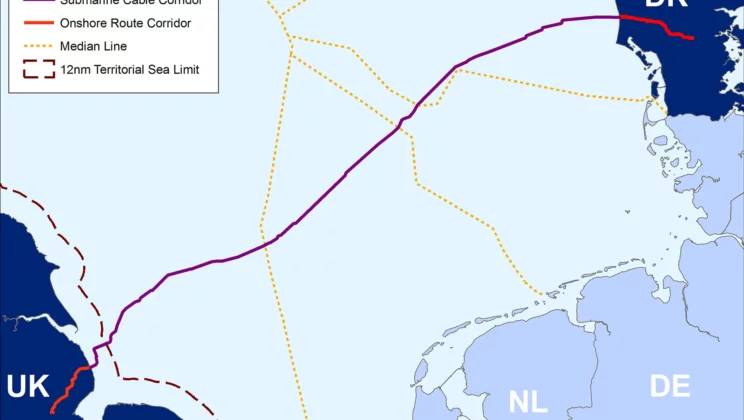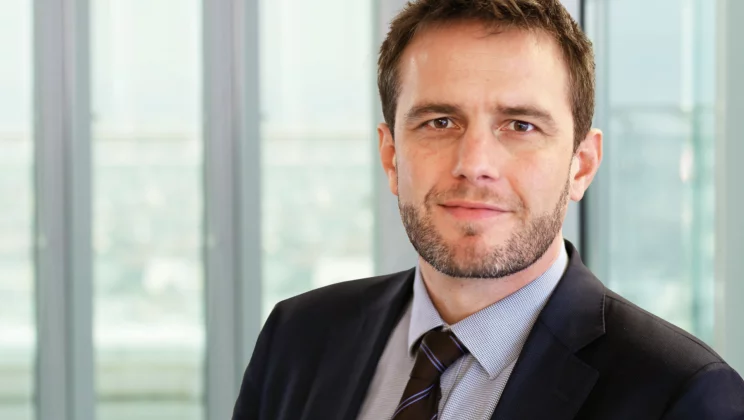The decision to spend DKK 11 billion on the Viking Link provides opportunities for a far better exploitation of Denmark’s wind resources and the transmission of green Danish power across Europe. “If I lived in Esbjerg, I’d bet my bottom dollar on there being enough jobs for many years to come,” says Kristian Ruby, Secretary General at Eurelectric. His words are echoed by Denmark’s Energy Minister Lars Christian Lilleholt, who cites Esbjerg as the model to strive for.
Recently, Minister of Energy, Supply, and Climate Lars Christian Lilleholt approved a project that saw Energinet invest a total of DKK 11 billion in a power cable connection to Britain and an extension of the power grid between Holstebro and the Danish–German border. This alone was a major decision.
But it is a decision that will have far-reaching implications.
“It makes good economic sense to strengthen our ties with other countries. This was our thinking when we decided to build the Viking Link, the world’s longest power cable, connecting Denmark and the UK,” says Lars Christian Lilleholt.
According to Energinet, Denmark stands to gain billions, socially and economically, from the Viking Link and the extension project in West Jutland. Because of their 40-year lifespan, these cables will generate socio-economic profits for Denmark of some DKK 4.7 billion in 2017 prices. Supply security will also improve significantly.
Eurelectric wants to go green
The Viking Link decision is very much in line with the course taken by Eurelectric, Europe’s electricity industry trade organisation, which has recently launched a new and very pro-active strategy. Eurelectric has 3,500 European member companies. Eurelectric reinforced this sentiment when it stated that the industry will become CO2-neutral well before 2050, supplying much greener and more sustainable electricity.
“We’re rapidly moving the goal posts,” say Kristian Ruby, Eurelectric’s Danish secretary-general. He personally views this new vision as “extremely ambitious”.
“There’ll be types of fuels and sectors that we’ll see being phased out completely going forward, with others being significantly reduced. Coal, for example, is a business that’s on the way out and we have industries on which we have already put a sell-by date,” he says.
Lars Christian Lilleholt and the Danish Government have set themselves the target of scrapping coal as an energy source for electricity supply by 2030. This is another reason why the minister welcomes the clear vision of the European electricity companies to transition to CO2-neutral production.
“To me, this means that the private sector now views a green economy as an opportunity for development and growth. In Denmark, we are well underway, with renewable energy accounting for more than 50 percent of electricity supply,” Lars Christian Lilleholt says.
The huge resource that is the North Sea
While things are looking gloomy for coal, the situation with sustainable electricity could not be more different. Kristian Ruby says that it has made “gigantic strides” over the past ten years. He believes that, unlike many other European countries, Denmark is able to rely on a huge resource.
“We have wind. And we have a lot of it. The North Sea is a unique resource and one that we must and will exploit. We’ll have more large wind turbines and cables going inland. The power they generate will also be used by mainland Europe in the future, so why not use longer cables and reap greater rewards? To lay the foundations of a new, CO2-neutral reality by 2050, we need large quantities of renewable energy. And quickly, too,” he says.
Lars Christian Lilleholt agrees with him, arguing that an internal offshore wind market in the North Sea needs to be developed. For precisely this reason, Denmark is part of a North Sea project that will see several countries bordering the North Sea jointly taking measures designed to cut the cost of offshore wind power and to enable the North Sea to become a power hub for the whole of Europe.
“The Danish Government aspires to see offshore wind become fully competitive, and I firmly believe that the North Sea will be the first place in the world where offshore wind can be set up without state subsidy,” he says.
However, Lars Christian Lilleholt does not think that establishing wind production should be Denmark’s only goal because the country also needs to invest in projects that will enable it to buy and sell electricity across its borders.
“In the future, especially as the proportion of renewable energy in the energy mix continues to rise, Denmark stands to reap greater benefits by having the capacity to transmit a lot more electricity if it wishes to make the most of its resources. Strong international connections, such as the Viking Link, are therefore essential for a competitive, safe and green electricity economy in Europe,” he says.

The Viking Link will consist of some 630 km of subsea high-voltage cables connecting Denmark, the Netherlands, Germany, and the United Kingdom across the North Sea. About 210 km of such subsea cabling will be in Danish waters.
Esbjerg to play a key role
Both Kristian Ruby and Lars Christian Lilleholt agree that the Port of Esbjerg will play a key role in the transition that will take place over the coming years.
“If I lived in Esbjerg, I’d put my bottom dollar on there being enough jobs for many years to come,” Kristian Ruby says. Lars Christian Lilleholt shares Ruby’s view of the port, already seeing the Port of Esbjerg as a key hub for energy production in the North Sea:
“The combination of the port’s strong position and the rapid development we’re currently witnessing in the North Sea makes me very optimistic about the port’s future. For me, that’s a brilliant example of how a green economy can create growth and new jobs for Denmark,” he says.
Making new industries electricity-based
For Kristian Ruby, a green economy opens up a wide range of business opportunities for Denmark. But it will require several new industries to switch to electricity. There are opportunities in the transport industry, for example, but we need state subsidy for transport to transition because it is currently so heavily taxed.
“Unlike wind turbines, transport isn’t an industry from which Danish exports and Danish jobs stand to reap major benefits,” says Lars Christian Lilleholt, and so he has no immediate plans along those lines.
Kristian Ruby is irked by such an attitude. He believes that Denmark is asleep on the job.
“As one big company after another makes multi-billion investments, we’re going through a diesel crisis and so on. We need to create synergies between the transport, electricity and energy storage industries. We don’t seem to realise there’s an enormous potential to be tapped here. All eyes are on Denmark now because we’re leading the way. There’s still a long way to go. Since we’re about to miss the boat, we need to get more industries on board,” Kristian Ruby says.

For Kristian Ruby, a green economy opens up a wide range of business opportunities for Denmark.
Already at work on ambitious targets
Lars Christian Lilleholt believes that the Danish Government is already being ambitious with its target for 50 percent of Denmark’s energy consumption to be supplied by sustainable sources by 2030.
“Not only that, we also have the long-term goal of making Denmark a low-emission society independent of fossil fuels by 2050. Those are the indicators showing that Denmark will continue to play a pioneering role,” says Lars Christian Lilleholt.
He points out that, in its forthcoming energy campaign, the Danish Government will present a series of initiatives to support green development and to ensure that Denmark achieves its targets. The Viking Link is one of the contributing projects.
“Strong power connections to the outside world are vital for a small nation like Denmark. We’ll be able to sell our power in a larger market when we generate a surplus of renewable energy. Meanwhile, we’ll have a greater range of supply on offer for Denmark when the winds are down and the sun isn’t shining,” he says.
Go to overview

